3D geological and infrastructure objects
Have you ever imagined what it's like to parachute? Have you ever wished to teleport to a distant land? Take a peek at another time in history?
The wishes of experts working at STC are somewhat more modest – they wish to get a better picture of the geological and infrastructure object in the projects they are engaged in.
All of these experiences can be provided by virtual glasses – a helmet, a technology called virtual reality, which provides the illusion that virtually non-existent things defined and stored only in computer memory can be seen, heard, touched, and felt.
At the moment, we have two virtual reality applications in STC: one is in engineering and represents a 3D representation of objects that can be used for the so-called virtual tour through the object from the project stage. Practically, from the very beginning of the project, the investor has the possibility to see the future object "live". This can avoid modifications and errors during construction and exploitation.
The second option is its use in special software, i.e. work on models obtained using this software. In geological interpretation, it is also possible to "immerse" in a three-dimensional geological object, i.e. a model in which layers, faults, geological structures, and channels of a potential hydrocarbon deposit are seen, which can significantly help the work of a geologist and make it significantly more efficient.
- VR equipment is used to display 3D models of newly designed and/or newly existing installations in a virtual environment. When we get a new project, it is easier to present it to the client with the help of VR equipment. It is also used for engineering analyses of the newly designed system in terms of accessibility of installations, HSE barriers, quality use of free space, and similar parameters that are more difficult to spot through monitors – explains the project manager of the Department of Infrastructure Design Stefan Pajević.
His colleague Dejan Mirković adds the thesis that virtual reality represents the future, but also the present when it comes to NTC.
- As a master engineer in geodesy and geoinformatics with a great interest in innovative technologies, automation, and machine learning, I am very pleased to have the opportunity to use virtual reality in my work at NTC. Thanks to it, we can make our business easier because we can see the plant without going to a physical location – says Dejan.
Virtual reality development is considered to have begun with a machine constructed by Edwin Link more than 90 years ago, which made the passengers feel like they were flying an airplane. In the early 1960s, Morton Heilig constructed the Sensorama device, which, using light, sound, motion, and smell, "immersed" the participant into the motorcycle ride through Brooklyn and other cities. This device later evolved into a pilot training device. Innovations from 1960 to 1970 contributed to the advancement of virtual reality technology.

